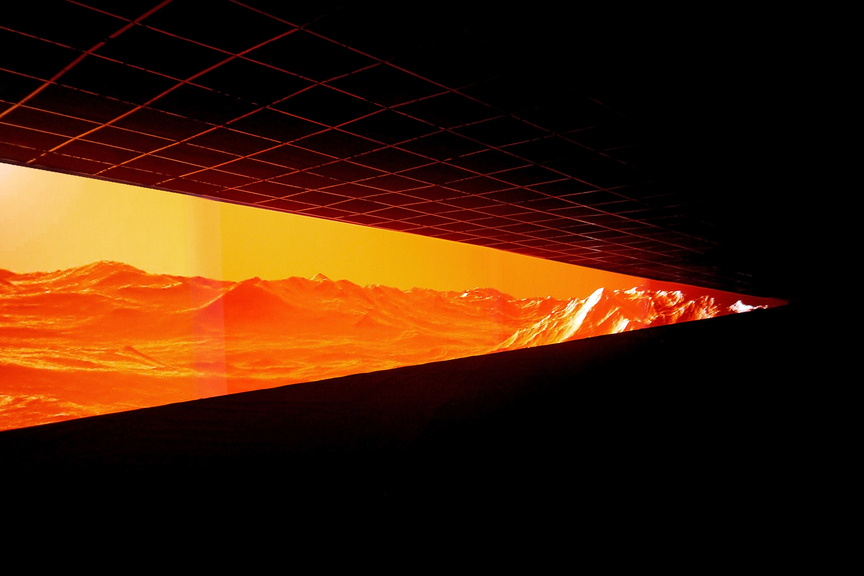
R
E
V N
E
X
T
The newly commissioned multi-part MOUSEN+MSG installation, titled The Great Chain of Being – Planet Trilogy (2016), was impressively situated on the first floor of the Power Station of Art. Visitors were encouraged to enter an abandoned space shuttle, which then leads to a series of underground chambers that narrate the trilogy of “Infinite Perspective,” “The End of Time,” and “Towards Darkness.” Over 40 artists collaborated for this work, focusing on three key references: Red Flag Canal, Samuel Beckett and William Shakespeare. Courtesy Power Station of Art, Shanghai.
At the 11th Shanghai Biennale, curators Raqs Media Collective made a radical proposal. The 92 participating artists from 40 countries were asked to architect imagined futures, encounters and narratives from within Asia—and with those resulting works, the Raqs Media Collective (Jeebesh Bagchi, Monica Narula and Shuddhabrata Sengupta) restructured the various levels and sections of the Power Station of Art (PSA) in Shanghai into connected archipelagos of intersecting desires.
“Why Not Ask Again: Arguments, Counter-arguments, and Stories” encompassed three floors of the gargantuan state-run museum, divided into four sections: Terminals, in which expressive bodies of work augmented ideas within PSA; Infra-Curatorial Platform, in which sub-exhibitions were mounted; Theory Opera, which dissolved the boundaries between thought and practice; and 51 Personae, in which invited participants shared multimedia stories across the city of Shanghai. Raqs Media Collective claimed to enjoy “lingering in discussions around the limit: the limit of the perfect question,” and provoked artists to question the nature of thresholds—of the East-West dichotomy, imagination and art itself—with a series of unexpected sources including a 7th century star map, the 1974 film Jukti, Takko aar Gappo (Reason, Debate, and a Story) and the novel The Three Body Problem by Liu Cixin. In the novel, a self-destructive stellar system faces complete extinction due to chaotic gravitational forces, which have forced 11 of 12 planets to collide with the sun. The remaining planet is also headed the same way; for its citizens, each scalding sunrise is a reminder of the imminent termination of life.
The Biennale also presented terrifying, not-too-distant imagined scenarios. Post-apocalyptic landscapes, rendered in Mousen+MSG’s underground theme park, were complete with technological waste and a live bee-infested tree. Our own identities unfolded in profound and disturbing ways, as enacted in Olivier De Sagazan’s gendered performance Transfiguration. Sun Yuan and Peng Yu’s So Far (2016) built tension, in which two giant forklifts continually attempt to pull apart compressed crocks. But hopeful futures were explored too, reflected in Christine Sun Kim’s sketch series based on the gesture for “future” in American Sign Language, and Lee Mingwei’s poetic Our Labyrinth (2015– ), featuring a dancer silently brushing golden rice grains across PSA’s cold, concrete floors.
These scenarios coalesced to produce more questions, rather than answers or blame; as Raqs Media Collective co-founder Monica Narula stated, the biennale was “not exactly about what we have done, but how we can live, and do live, in these contemporary conditions.” But it seemed to point out—perhaps even more poignantly given that 2016 was fraught with instability—the impossibility of the infinite. When will the forklifts pull apart the crocks, releasing whatever unknown contents sealed within? How soon before economies are run aground, our capital is depleted and nations, or what’s left of them, are laid to waste? How will we survive the collapse of our constructed societies? Most importantly, what happens next?
The 11th Shanghai Biennale takes place until March 12, 2017.
Ysabelle Cheung is managing editor at ArtAsiaPacific.
To read more articles on China, go to our digital library: https://library.artasiapacific.com/





